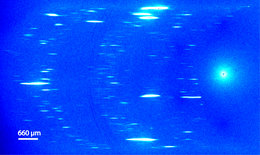Measurement of the size of methane hydrate crystallites. They are are up to ten times larger than previosly thought. The mean grain sizes are in the range from 300–600 μm. (Credit: Marum)

The graduate Stephan Klapp of the graduate school GLOMAR - Global change in the marine realm at the University of Bremen received the GLOMAR Paper Award 2007 for his contribution to the outstanding publication "First determination of gas hydrate crystallite size distributions using high-energy synchrotron radiation" in Geophysical Research Letters on Jan 11, 2008. The prize is endowed with 1000 Euros.
Stephan Klapp and his colleagues from the University of Göttingen were able to determine for the first time grain size distributions of six natural gas hydrates for samples retrieved from the Gulf of Mexico and from Hydrate Ridge offshore Oregon from varying depths. High-energy synchrotron radiation from beamline BW5 at DORIS III provides high photon fluxes as well as high penetration depth and thus allows for investigation of bulk sediment samples.
The gas hydrate crystallites appear to be (log-) normally distributed in the natural samples and to be of roughly globular shape. The mean grain sizes are in the range from 300–600 μm. Laboratory produced methane hydrate, starting from ice and aged for 3 weeks, shows half a log-normal curve with a mean value of ~40 μm. This one order-of-magnitude smaller grain sizes suggests that care must be taken when transposing grain-size sensitive (petro-)physical data from laboratory-made gas hydrates to natural settings.
GLOMAR has been established in November 2006 as part of the German excellence initiative and is financed by the Deutsche Forschungsgemeinschaft (DFG).
Their results were published in Geophys. Res. Lett. (2007).
(from: ...Paper and Press Release)
| Further Links |
|





